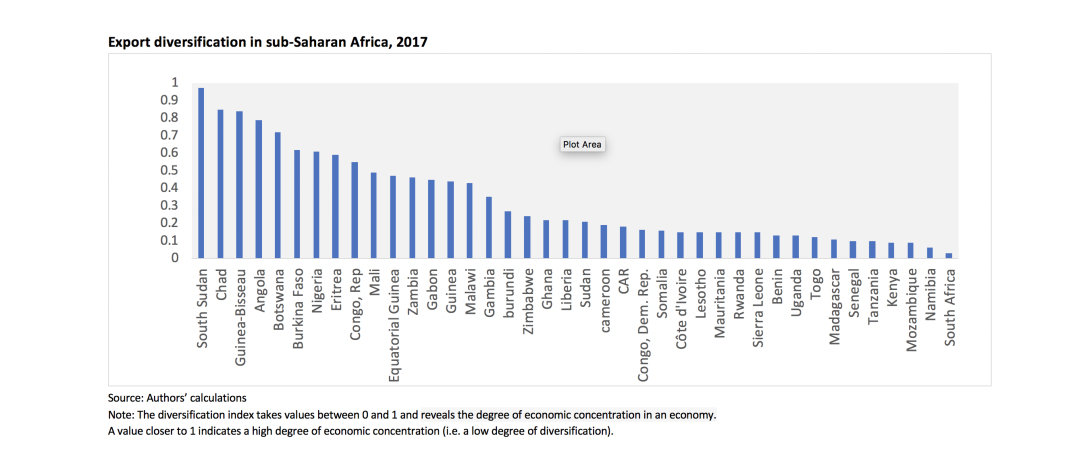|
|
|
A lack of economic diversification is often associated with increased vulnerability to external shocks that can undermine prospects for longer-term economic growth. The world’s poorest countries, many of which are often small or geographically remote, landlocked and/or heavily dependent on primary agriculture or minerals, tend to have the most concentrated economic structures.
This creates challenges in terms of exposure to sector-specific shocks, such as weather-related events in agriculture or sudden price shocks for minerals. Growth tends to be unbalanced in the case of mineral-dependent countries or slow and difficult to sustain in agrarian ones. Poverty-reducing, trade-driven growth has been particularly difficult to achieve in countries whose economies are heavily dependent upon primary commodities.
Countries whose geography implies a punishing lack of connectivity to regional or world markets are also at a distinct disadvantage in attempting to diversify their product and export mix. Of all the world’s regions, sub-Saharan Africa arguably suffers most from high levels of economic concentration.
Export diversification in sub-Saharan Africa, 2017

Economic diversification matters for development...
Economic diversification is a key element of economic development in which a country moves to a more diverse production and trade structure. Diversification helps to manage volatility and provide a more stable path for equitable growth and development. Successful diversification is all the more important now in the wake of uncertain global growth and the imperative in many developing countries to increase the number and quality of jobs.
Moving labour from low productivity employment, mainly in agriculture, to higher productivity jobs in a range of mostly urban activities characterised by strong agglomeration economies is imperative for sustained growth. While rapid increases in working populations offer many developing countries an opportunity for a demographic dividend, reaping it may remain challenging in the absence of economic diversification and job-producing private sector growth.
The need for government action through well designed public investments and effective policy reforms that support a more diversified economy remains centrally important.
…and trade matters for economic diversification
Trade expansion is central to creating new, higher productivity jobs that will facilitate growth through structural transformation. Integration into the global economy lies behind the success of many countries in diversifying their economies, driving far-reaching poverty reduction in the process. Export diversification should be seen as an objective in itself to reduce vulnerability to adverse terms of trade shocks and stabilise export revenues.
The nature and structure of protection in overseas markets shape the opportunities for export diversification in developing countries. This is especially so if overseas protection is biased towards products in which developing countries enjoy a comparative advantage.
For example, tariff escalation in developed countries has long constrained opportunities for developing countries to add value to and develop additional activities around agricultural and mineral products. Similarly, for light manufacturing, import tariffs on products such as clothing and shoes are typically much higher than those on textile fabrics and leather.
To some extent, this constraint has been alleviated by multilateral trade liberalisation through the World Trade Organization (WTO), which has reduced tariff peaks in rich countries and through the provision of non-reciprocal tariff preferences for developing countries. Still, the latter are frequently undermined by unduly restrictive rules of origin.
Regional integration and deepened South-South trade also represent effective mechanisms to increase new market opportunities for exporting firms. Diversifying exports to higher income markets is often more difficult than diversifying exports to regional markets. Standards are often higher, requiring larger investments to raise quality and meet health and safety requirements.
For this reason, diversification through exports to nearby countries with similar tastes and regulatory requirements – and hence potentially lower compliance costs – may prove easier. So too will South-South trade. Expansion in such markets can then provide the springboard for enlarged access to the global market once experience with exporting has increased and awareness of product requirements in other markets has risen.
Tariffs on imports can act as a constraint to export diversification and to sustained insertion in regional or global production networks. The level of import protection determines the incentives to produce exportable goods by directly raising the domestic price of imports relative to exports. Also, tariffs on intermediate inputs used by exporters in the absence of well-functioning duty drawback schemes increase the cost of producing goods for export and therefore, will reduce output of tradable goods.
It is also important to address non-tariff measures as part of a diversification strategy. Rules and regulations in overseas markets governing border procedures, technical regulations and standards can raise trade costs and limit entry by new exporters, especially when they are designed in a way that discriminates against trade.
The WTO provides needed disciplines on discriminatory regulatory measures and a forum for challenging regulations that arbitrarily discriminate against suppliers under the Technical Barriers to Trade (TBT) and Sanitary and Phytosanitary (SPS) agreements. The WTO’s Trade Facilitation Agreement similarly favours the adoption of best practices in customs procedures. Preferential trade agreements that include provisions for the harmonisation or mutual recognition of product standards can also help reduce the costs associated with regulatory diversity.
Services trade policies can spur diversification through the expansion of services exports. They can also promote the diversification of goods exports through improved access to a wider range of more efficiently produced services inputs. High costs for energy, telecoms, logistics and finance erode the competitiveness of firms and deter them from diversifying production and exports.
As countries develop, service sector liberalisation can help firms to meet supply requirements, diversify and integrate into regional and global value chains in goods and services alike. Efficient services are also crucial for taking advantage of modern distribution channels. Producers are increasingly using e-commerce to sell directly to consumers through web-based outlets.
However, diversification toward services exports can be hampered by regulatory diversity. To address this challenge, service sector reforms need to go beyond trade openness and focus on the simplification, harmonisation and/or mutual recognition of domestic regulations.
Final thoughts
No single formula exists that can promote an orderly process of structural change able to enhance the resilience of economies to external shocks and provide citizens with the more productive employment opportunities they need to sustain improved livelihoods.
Policy must always and everywhere adapt to the specific circumstances, differing geographies and endowments, and contrasted institutional, governance and implementation capacities of countries at differing levels of development. The success of diversification efforts ultimately depends on the mix, sequencing and timing of investments, policy reforms and institution building, and on their consistency with the underlying assets and related comparative advantages of any given country.
Investments in skills, infrastructure, institutions and governance quality – i.e. enhancing the transparency, accountability and predictability of government decision-making – increase the likelihood of success of diversification but are in turn affected by the extent of diversification.
------------
* The authors work in the Macroeconomics, Trade and Investment Global Practice of the World Bank Group. This article draws on a chapter entitled "Economic Diversification: Lessons from Practice", contributed by the authors to Aid for Trade at a Glance 2019, a forthcoming joint publication of the Organisation for Economic Co-operation and Development and the World Trade Organization. The views expressed in this article are those of the authors and should not be ascribed to the World Bank Group or its shareholder governments.
--------
This policy series has been funded by the Australian Government through the Department of Foreign Affairs and Trade. The views expressed in this publication are the author’s alone and are not necessarily the views of the Australian Government.
If you would like to reuse any material published here, please let us know by sending an email to EIF Communications: eifcommunications@wto.org.



